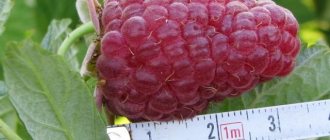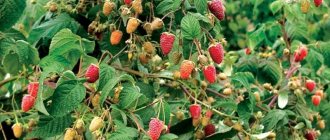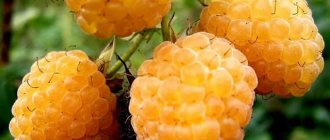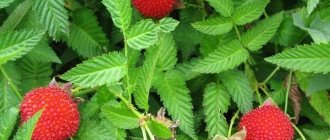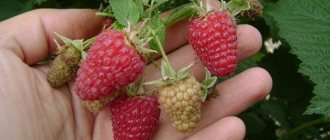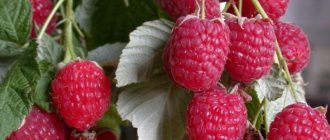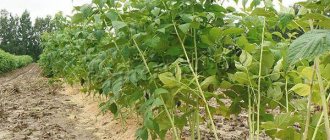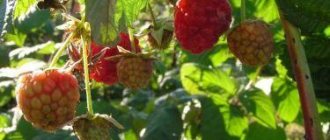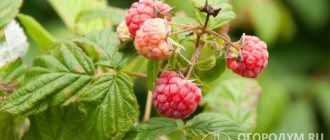The exclusivity of Glen Fyne
AGRO PREMIUM is an innovative, environmentally friendly plant activator, without chemicals, that protects berries, fruits and vegetables from pests and diseases, increases seed germination, stimulates root formation and plant growth, and significantly increases productivity.
The uniqueness of the Glen Fine raspberry variety lies in the plants themselves, with their bushes and fruits.
A culture with powerful rhizomes and shallow auxiliary roots. In loose soil they grow with a depth of 40 - 60 cm, in dense soil - 15 - 10 cm.
Horizontal lateral roots allow the formation of growth buds for the subsequent growth of new shoots. If there are more shoots than necessary, they are removed over the summer so that only replacement ones remain.
Bushes of tall plants. If you follow all the rules of agronomy and create favorable conditions, you will get bushes 2.5 m long. Replaced shoots live for two years.
- First, the formation of fruit buds occurs in the first year of life, in the fall.
- Then, in the spring of the second year, the replacement shoots bear fruit.
As gardeners have noticed, many fruits are always removed from the middle parts of the stems.
Glen Fine raspberries begin to bloom in early summer. This is the month of June.
Bisexual flowers, so plants:
- At first with a good ovary.
- Then, after the ovary, red, elongated berries are born, with 5-6 grams. There are also 10 grams.
The fruits are collected in several stages, due to the long fruiting of the crop.
The berries ripen well and stay on the bushes, do not lose their taste for up to 5 days. Which is very welcomed by summer residents who rarely visit their garden.
The yield of fruits with a sweet taste and exquisite aroma is about 30 kg per 1 m2.
Description
The shoots of Glen Ample are strong, erect, slightly leafy, green in color, with a slight waxy coating, and have excellent growth vigor. With age (in the second year) the shoots become woody. The leaves are green, closer to yellow-green, slightly wrinkled, rounded, with slight pubescence. The flowers are large, 2.2 cm in diameter. A big plus of this raspberry is that the shoots are absolutely smooth, without any thorns, which makes caring for the plant easier and turns picking berries into a very pleasant and uncomplicated event. Provided, of course, that the stems are placed correctly on the trellis, so that you don’t have to jump around the plantings with a ladder.
The average height of the stems is about 2 meters, but with good agricultural technology they can easily reach 3.5 meters and have truly enormous fruiting potential. On one shoot, from 20 to 30 laterals (fruit branches) 0.5−0.7 m long grow, on which, after flowering, up to 20 berries are formed each. The width of the bush itself reaches 2 meters; this must be taken into account when choosing a planting scheme, in particular when choosing the row spacing.
The berries of the Scottish variety have a beautiful round-conical shape, bright red color, with a weak or medium shine; when fully ripe, they darken. Raspberry fruits are large (on average length 23.2 mm, width 22.3 mm), dense, juicy, but with elastic skin. There is a consistently large percentage of one-dimensional and large fruits of excellent presentation. The average weight of Glen Ample berries in a season is 4 grams, but some specimens can gain a maximum weight of 6-8 grams.
Fruits with a rich raspberry aroma, pleasantly refreshing, sweet and sour taste, rated 4 out of 5 possible points. The BRIX sugar level is quite high at 10.5. The drupes are large, tightly interlocked; when harvested, ripe berries are easily removed from the bush and do not crumble. The transportability and shelf life of the fruits are good, they do not crush much during long-term transportation, and can be stored for 2-3 days without refrigeration and loss of commercial quality. And at a temperature of +2°C in the refrigerator, the shelf life is 6-8 days.
Glen Ample is distinguished by high and stable productivity, it bears fruit along almost the entire length of the stem, resulting in 1.2-1.6 kg per shoot and a total of 22-25 tons per hectare when planted with a row spacing of 2.5-3 meters. The shoot-forming ability of raspberries is good, there are a lot of root shoots even on old plantations, and therefore there are no difficulties in propagation.
The variety has a medium fruiting period and ripens from mid-June in the southern regions of our country. In the UK, namely in the city of Dundee (Scotland), the start of berry picking is on July 12, 50% of the harvest is on July 21, and the end of the harvest is already on August 6. And, for example, the beginning of the season at Brogdale Hortcultural Trust (Kent, UK) falls on June 24, 50% of the sample is on July 13, and the end of the harvest is on July 31.
The frost resistance of the variety is good; it has been verified that in the conditions of our country it can withstand frosts down to -35°C. For successful wintering, it is recommended to bend the shoots in late autumn and fix them to each other or braid them in a horizontal position. Glen Ample is resistant to raspberry aphids and other common crop diseases, but is susceptible to dwarf virus.
Considering the width of the bush, when planting raspberries, it is highly recommended to adhere to the following scheme, especially if you plan to grow on an industrial scale: the distance between plants in a row should be 0.5-0.6 meters, between rows - at least 2.5-3 meters. This scheme is necessary for ease of care, since when planting with a row spacing of 2 meters (and some managed to plant with a row spacing of 1.5 meters to save space), the result was an impenetrable forest, and the search for berries turned into a whole exciting adventure, fortunately, There are no thorns on the raspberry shoots, otherwise it would be completely impossible to get to the berries.
The variety is universal, consistently producing many large, tasty berries of excellent quality, well suited both for fresh consumption and for processing, canning and freezing. Glen Ample is perfect both for summer cottages and for growing on an industrial scale.
Back and forth
Characteristics of Glen Fine raspberries
These are unique plants that Scottish scientists have worked on extensively.
- Glen Fine raspberries with medium early ripening. Has no thorns.
- Compared to Emple raspberries, Fine ripens three days earlier.
- They are grown in open areas and in greenhouses.
- You can grow bushes on a large scale for farms.
- The culture is frost-resistant and drought-resistant.
- Thanks to the powerful and strong growth of tall bushes 2-2.5 meters high, trellises can be avoided.
- Fine produces a lot of shoots, you can multiply them and remove the excess.
- Culture in the south is gaining momentum. Already at the end of summer she has flowers and ovaries on the tops of her branches.
- The variety has strong immunity to viruses.
The disadvantages are sensitivity to raspberry diseases, which are:
- root rot;
- late blight;
- powdery mildew.
Gardeners have also noticed that dwarfism may occur in plants.
Thus, the features of the landings are as follows:
- Raspberries should not be planted in dense, clay soils;
- no need to over-water the crop
- The seedlings will be reluctant to take root if there are no replacement buds, or if they are injured during planting.
- Plants should not be planted in areas with high groundwater levels, in areas of flooding and wet loam.
History of variety selection
Glen Fine is a continuation of the famous series of Scottish raspberry varieties under the common name Glen. Despite its youth, the hybrid received several well-deserved awards. In 2009, the variety was named the most delicious in the UK, and in 2010 - the most productive.
The Glen variety line is the most popular in Europe, where it is cultivated on an industrial scale. In England, Glen Fyne raspberries are grown en masse in greenhouses. The crop is suitable for small garden plots and large farms.
How Glen Fine raspberries propagate
If you listen to the opinion of gardeners, then root suckers are taken for propagation. For transplants, new places are needed where plants like:
- potatoes;
- tomato;
- eggplant.
Important!
It is necessary to dig up the soil for the crop, remove weeds, and fertilize it with organic matter.
Fine can be propagated at any time:
- summer;
- autumn;
- spring.
It is advisable for such plants to be planted in cloudy or rainy weather. This way they experience less stress.
What you need to do to ensure that you have high-quality planting material:
- Select annual shoots from healthy bushes. The thickness of the shoot is similar to a pencil (1.5 cm). No damage, spots on the trunks, thickening on the rhizomes
- Cut off ⅔ from the upper parts of the shoots so that they do not bear fruit. The length of the seedlings is from 10 cm. If there are up to 10, then the formation of flower buds will not occur. You also need to leave from 3 to 4 buds on them (on each).
- The shoots are planted in trenches or using nesting methods. With the trench method, raspberries are planted at a distance of 50 cm from each other, with a depth of up to 35 cm. 2-3 rooted plants can be placed in 40x40 holes, with a depth of up to 35 cm. Thus, it is possible to form strong, productive bushes, even if there is not enough free space on the plots.
- Raspberry roots are planted in a vertical direction. Make sure that the root collars are above the surfaces and not covered with soil, but that the planting holes are completely filled.
- Surface roots should be covered only with a 5 cm layer of soil.
- Be sure to lightly compact the soil and pour 5 liters of water onto one shoot.
Pay attention to the photo, it shows the correct planting of raspberries.
Be sure to cover the bushes with mulch from:
- fresh grass;
- straw;
- peat;
- sawdust;
- rotted manure.
If you follow the correct agricultural techniques, then the yield will be waiting for you next summer.
Attention!
If you are doing mulching, do not use fresh sawdust! This causes the soil to become acidic.
From one shoot you can grow planting materials for entire plantations. Just don’t propagate plants in extreme heat. Try to keep the thermometer scale down to at least 25 degrees.
Reproduction
Given the tendency to form root shoots, there is no point in experimenting with dividing the bush and cuttings. At any convenient time, you can select a cutting - a green shoot, which gardeners call "nettle" - and transplant it to a permanent place. When sanitary clearing a bush, 4-5 such shoots are left (the rest are removed immediately after they appear). At the time of transplantation, the layering should be up to 1 cm thick in diameter.
Caring for the Glen Fine raspberry variety
If you look at the characteristics and reviews, raspberry bushes are unpretentious. They are easy to care for, so even beginners can do this job. The main thing is to follow Fine agricultural technology.
The procedures are simple:
- watering;
- weeding;
- loosening;
- feeding;
- tying up shoots;
- removal of excess plants during growing seasons.
Now let's talk about everything in more detail.
Watering
The deadline for watering planted seedlings is 4 days, inclusive. For mature Fine raspberries, you need to watch the top layer of soil. As soon as it dries out, water it. As we said earlier, plants are drought-tolerant, but do not like extreme drying. Otherwise, they will die.
They can tolerate it for a week, which is what raspberry growers liked about this variety. They just need to be watered generously every week.
To preserve moisture and simplify the care of planted plants (loosening, weeding), it is best to mulch under the bushes. Make a layer of 10 cm. Then the soil will be loose, it will not dry out and a crust will form. And also weeds will not appear.
Feeding
Due to high yields, the root system weakens and this can affect the future poor harvest. That's why Glen Fine likes annual feeding.
They begin to feed raspberries in the spring and feeding continues throughout the summer. And even in the fall, when the last berry is picked.
Mineral fertilizers are used for fertilizing:
- potassium salt;
- superphosphate.
And also organic.
- Make solutions with mullein (1:6).
- Bird droppings (1:15).
- Green fertilizer.
Dry wood ash or infusions from it are also used. Because they contain, in large quantities, micro and macroelements.
Glen Fine raspberries grow with long shoots. Therefore, during strong winds they can break. To prevent this from happening, they must be tied in two places, with different heights, to the trellises. The replaced shoots are left on the beds a few at a time, the rest is removed so that they do not take away useful substances for themselves.
Landing
When choosing the optimal location for planting Glen Fine raspberries, it is necessary to take into account the characteristics of the site as a whole. An unpretentious variety of British selection will take root in any conditions, only for a yield of 30 kg/sq. I won't have to count.
What factors should be avoided when choosing a place to plant Glen Fine raspberries:
- The area after nightshade crops is usually infected with late blight and various root rots.
- Dense compacted soil does not allow the root system to feed a powerful bush.
- Damp and flooded areas only provoke oxygen starvation of the roots and the development of rot.
The best place for Glen Fyne raspberries is a sheltered, well-lit, fertile area with loose soil.
It is best to grow tall bushes on trellises. The bushes are planted at intervals in the row: 50 cm. The row spacing depends on the method of cultivation - from 2.0...2.5 m in garden plots to 3.0...4.4 m in industrial plots where agricultural machinery is used.
There are no special preferences when choosing a planting season: it can be autumn or spring - it depends on the circumstances.
Step-by-step landing instructions:
- The area for raspberries is dug up, the soil is cleared of weed roots.
- For 1 sq. m add 1 bucket of humus or compost for digging.
- The roots of the seedling are not buried - they maintain the same planting depth.
- Water the hole - about 5 liters of water per root.
- The ground is leveled and the root zone is mulched.
The seedling is cut into 3-4 buds, leaving a “stump” approximately 10-20 cm high.
Diseases and pests
Raspberry shoots have strong immunity to disease. But leaf spot and anthracosis can affect. To prevent this from happening, gardeners use Bordeaux mixture for prevention. They treat the bushes with this substance in early spring with an interval of 2 weeks. The last spraying is carried out after removing the fruits.
Pests can also pester raspberry varieties
The most harmful ones include:
- nematodes that are partial to root systems.
- raspberry weevils, which destroy everything from leaves, flowers, ovaries to ripening berries.
- gall midges, small mosquitoes that settle inside the bushes and devour all the nutrients until the bushes die.
How to deal with them:
- Nematodes and weevils are destroyed by spraying the leaves using a soap solution. Extracts from ash regularly pollinate plants.
- Gall midges are most afraid of karbofos. But it’s better not to multiply pests. This requires preventive measures, in the form of treatments several times in the spring and during the growing season.
- Mosquitoes die if the soil is dug up and wood ash is added.
Getting ready for winter
Try to feed and improve the health of Glen Fine plants so that they do not feel discomfort in winter. They will definitely thank you with a good harvest.
What should you do:
- Trim off fruiting shoots and first-year shoots if you notice that they are sick.
- Treat the shoots to prevent various pathogens from attacking the crop. Bordeaux mixture will help.
- Feed your raspberries with organic matter and minerals. Take the recommendations of experienced gardeners as a basis and make fertilizers from wood ash and manure. Such organic elements can replace potassium.
- Water thoroughly immediately after fertilizing.
- Bend the stems to the ground, still at above-zero temperatures.
- If you notice that the temperature has dropped, cover the plants. Use non-woven materials first. Then you can make a cover from: spruce branches, black soil or peat. Wrap the raspberries, but with the ends open so they can breathe.
- When mice crawl, decomposed poison will help.
- They completely cover the plantings when the temperature drops from 8 to 10 degrees.
- During snowfalls, provide additional cover for plants with snow.
Growing and care
Reviews from gardeners about Glen Fyne raspberries only confirm the unpretentiousness declared by the authors of the variety. If you use mulching around the tree trunk, then weeding, loosening and, for the most part, watering will not be necessary at all.
Watering
Bushes need watering only in the absence of precipitation during the most difficult periods for the plant:
- after planting during the acclimatization period in a new place;
- for the winter - moisture-charging watering for wintering;
- on the eve of flowering;
- during the period of ovary formation.
It is contraindicated to over-wet the soil - excess moisture leads to fungal diseases. Mulching helps solve two problems at the same time - it makes the work of the summer resident easier and creates optimal conditions for the growth of raspberries.
Top dressing
Fertilizing must be given to fruiting bushes annually. It is best to do this in 2 steps.
- in the spring - organic matter (humus, compost) for digging or mullein diluted 1:6;
- in the fall, after harvesting - a mineral complex for berry crops (Agricola, Master) or wood ash.
Trimming
Pruning fruit-bearing summer raspberry bushes is carried out in 3 steps:
- after harvesting, remove all fruit-bearing branches;
- before storing for the winter, sanitary cleaning of the raspberry tree is carried out, removing weak shoots affected by pests and diseases;
- in the spring, remove damaged, frozen branches and tie the shoots to the trellises.
Disease and pest control
Glen File raspberries are quite resistant to most diseases. To prevent late blight and powdery mildew, experienced gardeners recommend treating raspberry plantings with copper sulfate (blue spraying). Copper salts also affect overwintering insect larvae.
Preparing for winter
Preparing Glen Fine raspberries for winter is no different from the usual techniques for gardeners in the Central region:
- shoots are removed from the trellises;
- tied in bundles and laid on boards so that there is no contact with the ground;
- for the Central region, it is quite enough to simply press the shoots with arcs or boards, and with the arrival of winter, throw in more snow;
In regions with little snow, it is recommended to cover the tied branches with burlap or agrofibre.
What gardeners say about Glen Fine
Svetlana. Blagoveshchensk
We planted two varieties of Glen raspberries. And we couldn't be happier. Both Fine and Koe delight us with their unpretentiousness, excellent taste and productivity. Tell me where I can buy other raspberries from this series.
Alena from Ryazan
I have been involved in dacha business for five years. My neighbors are raspberry growers, so they give me raspberries. Glen Fine recently appeared. My children really like raspberries. They are delighted with the taste of the berries. I also make jam from them. Yummy, still the same. And caring for the plants is very easy. A week later we come with the whole family and water and feed when necessary. I recommend. You will not regret.
Landing Features
Growing Glen Fyne raspberries is easy. This variety is undemanding to growth conditions and care. But without proper attention, although the crop grows successfully, the yield will still be average. Reproduction is usually carried out by shoots, because this variety produces them in large quantities. The place for planting is chosen to be sunny or shaded, but this variety cannot be planted in the shade.
Planting is carried out in spring or autumn. It is advisable to do this in cloudy weather, then the seedlings will take root faster. The area is fertilized and dug up in advance. When planting one bush, a hole is made, and when planting several bushes, a trench is made.
The seedling is selected as an annual one, slightly thicker than a pencil.
The seedling is selected as an annual one; the thickness of the main shoot should be slightly larger than the diameter of a pencil. Before planting, the tops of the shoots are cut off so that the young plant takes root and does not begin to bear fruit prematurely.
Bushes are planted at a distance of 50-100 cm from each other. A space of 1.5 meters is left between the rows. This will prevent thickening and allow the bushes to develop freely. When planting, the root collar must be above the surface of the soil - it cannot be buried! After planting, the raspberries are watered and mulched with straw, sawdust or peat.
